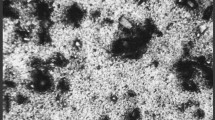Abstract
Heterocyclic organic molecules containing oxygen, nitrogen or sulfur are generally used as inhibitors for corrosion protection of copper. These compounds form protective films by adsorption onto the metal surface. Nevertheless, most such inhibitors are biologically toxic, hence there is a need for development of ecofriendly inhibitors. Chitin is a nontoxic biological polymer that is known to be enzymatically biodegradable. In the present study chitin was chemically modified to phosphorylated chitin (PCT) to make it soluble in aqueous medium and increase its complexing ability with metal ions. The ability of this modified polymer to inhibit corrosion of copper in aqueous NaCl and the nature of the inhibition process were investigated by gravimetric analysis, electrochemical impedance spectroscopy, and polarization measurements. X-ray photoelectron spectroscopy (XPS) and scanning electron microscopy (SEM) with energy-dispersive X-ray (EDX) analysis were used to examine the surface morphology and analyze the chemical composition of the film formed on the metal surface. Maximum efficiency of 92 % was achieved by addition of 200 ppm PCT as inhibitor to an aqueous corrosive environment containing 200 ppm chloride at 30 ± 0.1 °C. SEM studies revealed that the smoothness of sample surface was retained on PCT addition to the aggressive medium. EDX and XPS studies on the surface film revealed the presence of PCT. A plausible mechanism for the inhibition by PCT is suggested.













Similar content being viewed by others
References
W.A. Lanford, P.J. Ding, W. Wang, S. Hymes, S.P. Murarka, Mater. Chem. Phys. 41, 192 (1995)
K.S. Lokesh, M. De Keersmaecker, A. Elia, D. Depla, P. Dubruel, P. Vandenabeele, S. Van Vlierberghe, A. Adriaens, Corros. Sci. 62, 73 (2012)
M.M. Antonijević, S.M. Milić, M.B. Petrović, Corros. Sci. 51, 1228 (2009)
M. Behpour, N. Mohammadi, Corros. Sci. 65, 331 (2012)
E.M. Sherif, S.M. Park, Electrochim. Acta 51, 6556 (2006)
G. Moretti, F. Guidi, Corros. Sci. 44, 1995 (2002)
S.A. Umoren, U.M. Eduok, Carbohydr. Polym. 140, 314 (2016)
S. Cheng, S. Chen, T. Liu, X. Chang, Y. Yin, Mater. Lett. 61, 3276 (2007)
S. Cheng, S. Chen, T. Liu, X. Chang, Y. Yin, Electrochim. Acta 52, 5932 (2007)
S. Banerjee, V. Srivastava, and M. M. Singh, Corros. Sci. 59, 35
M. Sugimoto, M. Morimoto, H. Sashiwa, H. Saimoto, Y. Shigemasa, Carbohydr. Polym. 36, 49 (1998)
C. Songkroah, W. Nakbanpote, P. Thiravetyan, Process Biochem. 39, 1553 (2004)
A. Bhatnagar, M. Sillanpää, Adv. Colloid Interface Sci. 152, 26 (2009)
N.M. Alves, J.F. Mano, Int. J. Biol. Macromol. 43, 401 (2008)
F. Shahidi, J.K.V. Arachchi, Y.-J. Jeon, Trends Food Sci. Technol. 10, 37 (1999)
F. Khoushab, M. Yamabhai, Mar. Drugs 8, 1988 (2010)
J. Fangkangwanwong, M. Akashi, T. Kida, S. Chirachanchai, Biopolymers 82, 580 (2006)
W. Pasanphan, S. Chirachanchai, Carbohydr. Polym. 72, 169 (2008)
W. Tachaboonyakiat, N. Netswasdi, V. Srakaew, M. Opaprakasit, Polym. J. 42, 148 (2009)
N. Nishi, Y. Maekita, S. Nishimura, O. Hasegawa, S. Tokura, Int. J. Biol. Macromol. 9, 109 (1987)
R. Jayakumar, N. Selvamurugan, S.V. Nair, S. Tokura, H. Tamura, Int. J. Biol. Macromol. 43, 221 (2008)
R. Jayakumar, N. Selvamurugan, S.V. Nair, S. Tokura, H. Tamura, Int. J. Biol. Macromol. 43, 221 (2008)
ASTM NACE TM0169/G31–12a Standard guide for laboratory immersion corrosion testing of metals. (ASTM International, Philadelphia, 2012). doi:10.1520/G0031-12A
R.A. Freeman, D.C. Silverman, Corrosion 48, 463 (1992)
I.F. Amaral, P.L. Granja, M.A. Barbosa, J. Biomater. Sci. Polym. Ed. 16, 1575 (2005)
R. Jayakumar, T. Egawa, T. Furuike, S.V. Nair, H. Tamura, Polym. Eng. Sci. 49, 844 (2009)
E. Barsoukov, J.R. Macdonald, Impedance Spectroscopy (Wiley, Hoboken, 2005)
A.V. Naumkin, A. Kraut-Vass, C. J. Powell, S. W. Gaarenstroom, NIST X-ray Photoelectron Spectroscopy Database, Version 4.1. (National Institute of Standards and Technology, Gaithersburg, 2012). http://srdata.nist.gov/xps/
N.S. McIntyre, S. Sunder, D.W. Shoesmith, F.W. Stanchell, J. Vac. Sci. Technol. 18, 714 (1981)
G.P. Cicileo, B.M. Rosales, F.E. Varela, J.R. Vilche, Corros. Sci. 41, 1359 (1999)
C.C. Chusuei, M.A. Brookshier, D.W. Goodman, Langmuir 15, 2806 (1999)
M.C. Biesinger, B.P. Payne, A.P. Grosvenor, L.W.M. Lau, A.R. Gerson, R.S.C. Smart, Appl. Surf. Sci. 257, 2717 (2011)
T. Yoshida, S. Sawada, Bull. Chem. Soc. Jpn 47, 50 (1974)
D. Chadwick, T. Hashemi, Corros. Sci. 18, 39 (1978)
Y. Zhou, S. Xu, L. Guo, S. Zhang, H. Lu, Y. Gong, F. Gao, RSC Adv. 5, 14804 (2015)
V.S. Sastri, J.R. Perumareddi, M. Lashgari, M. Elboujdaini, Corrosion 64, 283 (2008)
Acknowledgements
The authors are grateful to NIT Warangal, Telangana State, India, for providing all the facilities for the present research work. V.K.K. is grateful to the Director, NIT Warangal for an institute fellowship.
Author information
Authors and Affiliations
Corresponding author
Electronic supplementary material
Below is the link to the electronic supplementary material.
Rights and permissions
About this article
Cite this article
Vimal Kumar, K., Appa Rao, B.V. & Hebalkar, N.Y. Phosphorylated chitin as a chemically modified polymer for ecofriendly corrosion inhibition of copper in aqueous chloride environment. Res Chem Intermed 43, 5811–5828 (2017). https://doi.org/10.1007/s11164-017-2964-x
Received:
Accepted:
Published:
Issue Date:
DOI: https://doi.org/10.1007/s11164-017-2964-x




